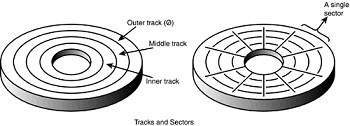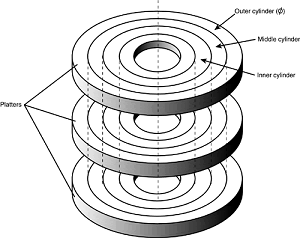Hard Disk Drive Operation
The basic physical construction of a hard disk drive consists of spinning disks with heads that move over the disks and store data in tracks and sectors. The heads read and write data in concentric rings called tracks, which are divided into segments called sectors, which typically store 512 bytes each.

Hard disk drives usually have multiple disks, called platters, that are stacked on top of each other and spin in unison, each with two sides on which the drive stores data. Most drives have two or three platters, resulting in four or six sides, but some PC hard disks have up to 12 platters and 24 sides with 24 heads to read them (Seagate Barracuda 180).
The identically aligned tracks on each side of every platter together make up a cylinder. A hard disk drive usually has one head per platter side, with all the heads mounted on a common carrier device or rack. The heads move radially across the disk in unison; they can't move independently because they are mounted on the same carrier or rack, called an actuator.

Originally, most hard disks spun at 3,600rpm—approximately 10 times faster than a floppy disk drive. For many years, 3,600rpm was pretty much a constant among hard drives. Now, however, most drives spin even faster.
Although speeds can vary, modern drives typically spin the platters at either 4,200rpm; 5,400rpm; 7,200rpm; 10,000rpm; or 15,000rpm. Most standard-issue drives found in PCs today spin at 5,400rpm, with high performance models spinning at 7,200rpm.
Some of the small 2 1/2'' notebook drives run at only 4,200rpm to conserve power, and the 10,000rpm or 15,000rpm drives are usually found only in very high-performance workstations or servers, where their higher prices, heat generation, and noise can be more easily dealt with.
High rotational speeds combined with a fast head-positioning mechanism and more sectors per track are what make one hard disk faster overall than another. The heads in most hard disk drives do not (and should not!) touch the platters during normal operation.
However, on most drives, the heads do rest on the platters when the drive is powered off. In most drives, when the drive is powered off, the heads move to the innermost cylinder, where they land on the platter surface. This is referred to as contact start stop (CSS) design.
When the drive is powered on, the heads slide on the platter surface as they spin up, until a very thin cushion of air builds up between the heads and platter surface, causing the heads to lift off and remain suspended a short distance above or below the platter.
If the air cushion is disturbed by a particle of dust or a shock, the head can come into contact with the platter while it is spinning at full speed. When contact with the spinning platters is forceful enough to do damage, the event is called a head crash.
The result of a head crash can be anything from a few lost bytes of data to a completely ruined drive. Most drives have special lubricants on the platters and hardened surfaces that can withstand the daily "takeoffs and landings" as well as more severe abuse.
Some newer drives do not use CSS design and instead use a load/unload mechanism that does not allow the heads to contact the platters, even when the drive is powered off.
First used in the 2 1/2'' form factor notebook or laptop drives where resistance to mechanical shock is more important, traditional load/unload mechanisms use a ramp positioned just off the outer part of the platter surface, whereas some newer designs position the ramp near the spindle.
When the drive is powered off or in a power saving mode, the heads ride up on the ramp. When powered on, the platters are allowed to come up to full speed before the heads are released down the ramp, allowing the airflow (air bearing) to prevent any head/platter contact.
Because the platter assemblies are sealed and nonremovable, the track densities on the disk can be very high. Hard drives today have up to 96,000 or more tracks per inch (TPI) recorded on the media (Hitachi Travelstar 80GN). Head disk assemblies (HDAs), which contain the platters, are assembled and sealed in clean rooms under absolutely sanitary conditions.
Because few companies repair HDAs, repair or replacement of the parts inside a sealed HDA can be expensive. Every hard disk ever made eventually fails. The only questions are when the failure will occur and whether your data is backed up.